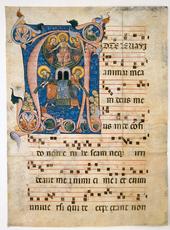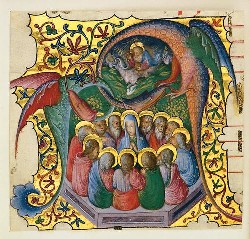
Medieval Object Description
The medieval objects I have studied from the Metropolitan Museum of Art are two illuminated pages from church prayer books. One is a depiction of the Last Judgment in the initial “a” and the other is a depiction of the Pentecost also in the initial “a”. The Last Judgment is circa 1270-80, while the Pentecost is circa 1430-35, and both are from Italy.
In the middle ages, church clergy illustrated leaves of song books which were sung by the choir in a book called the antiphonary. Eventually, these illustrations came together with prayer texts in a book called the gradual. Those who illuminated the books were influenced by the decorative art in the stained glass windows of the church.
Because these books were not considered the word of God, they were placed on the altar and meant to be held and used by everyone. The richly detailed pictures at the beginning of songs or readings helped communicate what the passages were about to everyone, including the illiterate. The purpose was not only to simplify the text for reading, but to make it more ornate for aesthetic purposes as well.
In the Last Judgment, Christ and the angels sit in the heavens announcing their arrival on earth. The picture predominately uses orange and blue colors. According to the Cleveland Museum of Art, “This image of the Last Judgment reveals the terror of the final moment: Christ sits above, exposing his wounds to the viewer, while angels sound trumpets and the dead, seen below, rise from their graves.” The picture accompanies music to a song which was probably about Christ's return to save or condemn all people.

The Pentecost leaf is by Stefano da Verona and depicts the Virgin Mary sitting among the 12 apostles as the Holy Spirit looks on from above. The space for the Holy Spirit is formed by the intertwining of the heads of two dragons. The Metropolitan Museum of Art lists the picture as a detail from a larger cutting of an antiphony.

Home ~ Pictures ~ Paper ~ Links ~ Works Cited